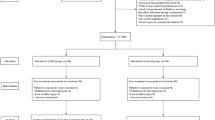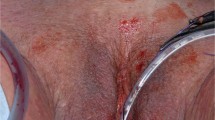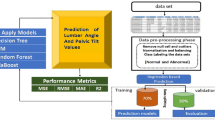Abstract
Study design:
Two case studies.
Objectives:
To determine whether 6 weeks of regular pelvic floor muscle training (PFMT) can improve the strength and endurance of voluntary contractions in incomplete spinal cord injury and reduce neurogenic detrusor over-activity (NDO) and incontinence.
Setting:
The London Spinal Cord Injury Centre, Stanmore, London, UK.
Methods:
A 6-week programme of PFMT was conducted in two male subjects with stable supra-sacral motor incomplete (AIS C and D) spinal cord injuries. Clinical evaluations before and after training comprised measures of strength and endurance of voluntary pelvic floor contractions both objectively by anal canal-pressure measurements and subjectively using the modified Oxford grading system. NDO was determined by standard urodynamic tests of bladder function and incontinence measured by the International Consultation on Incontinence Questionnaire-Urology.
Results:
Both subjects improved the strength and endurance of their pelvic floor muscle contractions by over 100% at the end of training. After training, Subject 1 (AIS D) was able to reduce bladder pressure during over-activity almost completely by voluntarily contracting the pelvic floor muscles. Subject 2 (AIS C) achieved a lesser reduction overall after training. Continence improved only in subject 1.
Conclusion:
These case studies provide evidence that a 6-week programme of PFMT may have a beneficial effect on promoting voluntary control of NDO and reduce incontinence in selected cases with a motor incomplete spinal cord lesion.
Similar content being viewed by others
Log in or create a free account to read this content
Gain free access to this article, as well as selected content from this journal and more on nature.com
or
References
Anderson KD . Targeting recovery: priorities of the spinal cord-injured population. J Neurotrauma 2004; 21: 1371–1383.
Wyndaele JJ Conservative treatment. In: Corcos J, Schick E (eds). Evaluation and Treatment of the Neurogenic Bladder, 1st edn. Taylor & Francis: London, UK, 2005, pp 125–136..
McClurg D, Ashe RG, Marshall K, Lowe-Strong AS . Comparison of pelvic floor muscle training, electromyography biofeedback, and neuromuscular electrical stimulation for bladder dysfunction in people with multiple sclerosis: a randomized pilot study. Neurourol Urodyn 2006; 25: 337–348.
Laycock J Clinical evaluation of the pelvic floor. In: Schussler B, Laycock J, Norton P, Stanton Sl (eds). Pelvic Floor Re-education. Springer-Verlag: London, UK, 1994, pp 42–48..
Hagen S, Stark D, Glazener C . Individualised pelvic floor muscle training in women with pelvic organ prolapse: a multicentre randomised controlled trial. Lancet 2014; 383: 796–806.
Acknowledgements
We thank Royal National Orthopaedic Hospital Charity, UK.
Author information
Authors and Affiliations
Corresponding author
Ethics declarations
Competing interests
The authors declare no conflict of interest.
Additional information
Supplementary Information accompanies this paper on the Spinal Cord website
Supplementary information
Rights and permissions
About this article
Cite this article
Vásquez, N., Knight, S., Susser, J. et al. Pelvic floor muscle training in spinal cord injury and its impact on neurogenic detrusor over-activity and incontinence. Spinal Cord 53, 887–889 (2015). https://doi.org/10.1038/sc.2015.121
Received:
Revised:
Accepted:
Published:
Issue date:
DOI: https://doi.org/10.1038/sc.2015.121



